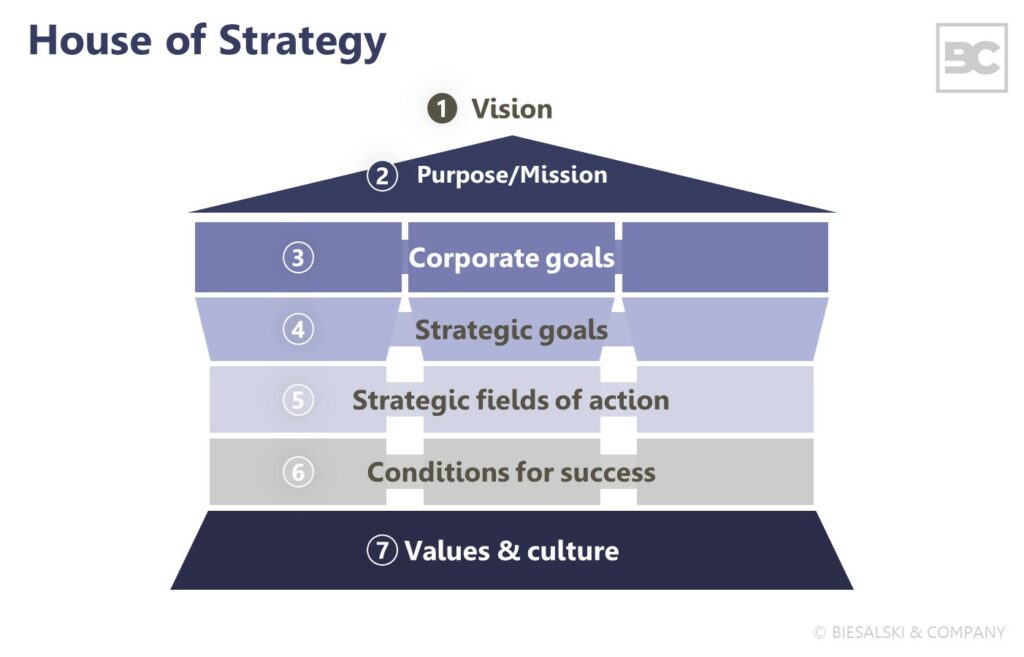Brand strategy
Brand strategy: Guide to success with the brand
“Business strategy drives brand strategy“? Should brand goals really be seen as less important than corporate goals? Should it not be vice versa? In any case it makes sense to reconcile and coordinate each direction of impact within your company. Corporate goals, brand positioning and marketing strategy form the basis for deciding on an integrated brand strategy that incorporates both internal goals and market-based requirements.
What is a brand strategy?
Brand strategy is a long-term plan developed by companies to manage how their target audiences perceive their brand. The brand strategy represents a framework of action to implement the brand that is binding for all participants. This guarantees that a clear, relevant and differentiating brand picture is consistently conveyed to the target group. A well-defined brand strategy enables an effective and efficient orientation of all company activities towards the needs of the target group, with the aim of increasing the return of the brand.
Why is a brand strategy so important?
The brand strategy forms the conceptual foundation for all future brand-relevant decisions. Therefore, it is important to deal with the topic in depth in order to be able to convey a uniform and transparent image both internally and externally. Only with a clear strategic compass can one’s own actions be purposeful, which is ultimately reflected in an increase in brand awareness, the creation of a positive brand image and the development of a loyal customer base.
What we offer
At first a comprehensive SWOT analysis is conducted that considers the past, present and future. Looking at the past it is important to understand the roots of the company’s history. The current status, on the other hand, examines
- your company using a product portfolio analysis,
- the market, by gathering information about the perceived competencies, the market position of your company as well as the competitive environment,
- the customers, by collecting information about their purchasing decision criteria, but also about the customer journey and
- the market, regarding the power of suppliers or buyers and backwards integration.
Finally, the analysis of the future considers the visionary objectives of your company, taking into consideration the corporate strategy as well as future developments and mega trends. Based on this clear, convincing vision, a motivating and inspiring mission and a meaningful purpose, the “House of Strategy” is developed. Starting from the corporate identity, overarching corporate goals are defined and, in turn, strategic focus topics for achieving these goals are broken down. Strategic fields of action and transparent success conditions serve as the basis for concrete implementation. In the end, values and corporate culture form the framework as the foundation of the company.

The next step is dedicated to deriving the strategic brand goals with regard to reputation, markets, target groups, products, pricing and distribution.
At last we will create a roadmap that includes the milestones necessary to achieve the set targets.
The aim of the process is to concretise the directions of impact for higher growth. In order to clarify how the brand can precisely support the value creation, a concrete mission for brand management is formulated. This enables the objective measurement, for example of the top three brand goals with the highest priority to support the future value creation. This way brand management receives a clear framework for orientating marketing activities.
Your benefit
The process helps you to create transparency regarding the status quo of your company. You define precise goals and draft a to-do list that enables you to reach these. As a result, you obtain a schedule relating to budget, responsible employees, timing and thus receive a clear business perspective.
On the one hand, this creates motivation, enthusiasm and an optimistic spirit. On the other hand, you can be sure that, overall, you are on the right track.
This does not only strengthen your company, but also marketing as a general driver of growth.
Contact me!
Alexander Biesalski
MANAGING PARTNER

